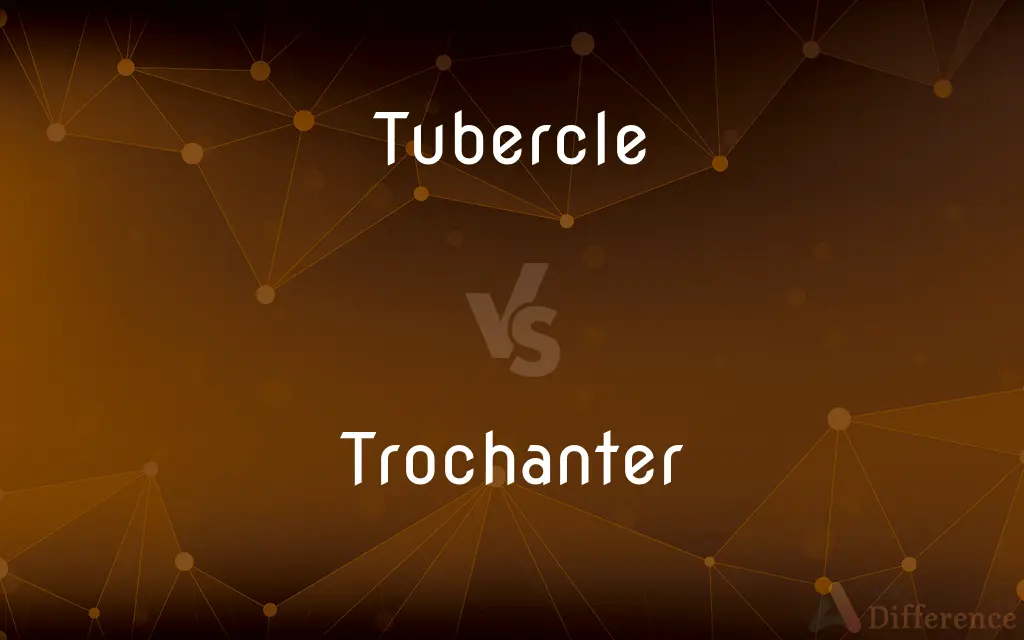Tubercle vs. Trochanter — What's the Difference?
By Fiza Rafique & Maham Liaqat — Updated on March 14, 2024
Tubercles are small, rounded projections or bumps on bones, often for muscle attachment; trochanters are large, prominent bony projections on the femur for muscle attachments.

Difference Between Tubercle and Trochanter
Table of Contents
ADVERTISEMENT
Key Differences
Tubercles are small, rounded protuberances found on various bones, serving as sites for muscle and ligament attachment. These structures are common in the skeletal system and vary in size and shape depending on their location and function. Tubercles can be found on bones such as the humerus, where they play a crucial role in the attachment of shoulder and arm muscles. On the other hand, trochanters are specifically large bony projections found on the femur, or thigh bone. They are notably larger than tubercles and serve as attachment sites for muscles and ligaments of the hip and thigh. The greater and lesser trochanters are the two main types, facilitating important muscle attachments that influence leg movement and stability.
While tubercles are involved in various skeletal functions across the body, they are generally smaller and less prominent than trochanters. Their presence on different bones, such as the ribs (as in the case of the costal tubercle) or the vertebrae, indicates their diverse roles in the musculoskeletal system. Trochanters, however, are exclusive to the femur and significantly contribute to the biomechanics of the hip joint. Their larger size corresponds to the heavier load and greater force exertion experienced by the hip joint compared to other areas of the body.
In terms of anatomical significance, tubercles may be involved in specific clinical conditions or syndromes related to the bones they are found on. For example, the tubercle of a rib can be a site of fracture or muscular strain. Conversely, trochanters are critical landmarks in orthopedic surgery and can be involved in fractures or pathological conditions affecting the hip, such as trochanteric bursitis. The different clinical implications highlight the distinct functional and anatomical roles of these bony projections.
The study of tubercles and trochanters aids in understanding the evolutionary adaptations of the skeletal system. Tubercles appear across a wide range of vertebrates, suggesting a fundamental role in muscle attachment that has been conserved throughout evolution. Trochanters, with their prominence on the femur, reflect adaptations to bipedalism and the demands of locomotion in humans and other bipedal species. This evolutionary perspective underscores the differences in function and significance between tubercles and trochanters.
Despite their differences, both tubercles and trochanters are integral to the musculoskeletal system, facilitating the attachment of muscles and ligaments necessary for movement and stability. Their study offers insights into anatomy, biomechanics, and evolutionary biology, highlighting the complexity and adaptability of the skeletal system.
ADVERTISEMENT
Comparison Chart
Definition
Small, rounded bone projection for muscle attachment.
Large, prominent bone projection on the femur for muscle attachment.
Location
Various bones throughout the body.
Exclusively on the femur.
Size
Generally smaller.
Larger and more prominent.
Functional Significance
Attach muscles and ligaments across various bones.
Specifically attach hip and thigh muscles for leg movement.
Clinical Relevance
Involved in conditions related to their specific bone locations.
Important in hip-related conditions and surgeries.
Compare with Definitions
Tubercle
An anatomical bump used as a landmark in medical examinations.
The tubercle of Zuckerkandl is a key landmark in thyroid surgery.
Trochanter
A prominent feature of the thigh bone involved in hip joint biomechanics.
Fractures involving the trochanter can severely impact mobility.
Tubercle
A small, rounded projection on a bone for muscle attachment.
The greater tubercle of the humerus serves as an attachment point for shoulder muscles.
Trochanter
An anatomical structure significant for leg movement.
The lesser trochanter provides attachment for the iliopsoas muscle.
Tubercle
A minor projection or bump on a bone distinct from larger structures.
The adductor tubercle on the femur is important for knee stability.
Trochanter
A critical landmark in orthopedic and anatomical studies.
Trochanteric bursitis is inflammation of the bursa near the greater trochanter.
Tubercle
A nodule or small eminence, especially one on a bone.
The costal tubercle provides an attachment for ligaments of the rib.
Trochanter
A major attachment site for muscles controlling the hip and thigh.
The gluteal muscles attach to the greater trochanter of the femur.
Tubercle
A small, rounded bump found on the surface of bones.
Palpating the tubercle on the wrist can help locate specific tendons.
Trochanter
A large, bony knob on the femur for muscle attachments.
The greater trochanter is easily palpable on the side of the hip.
Tubercle
In anatomy, a tubercle (literally 'small tuber', Latin for 'lump') is any round nodule, small eminence, or warty outgrowth found on external or internal organs of a plant or an animal.
Trochanter
A trochanter is a tubercle of the femur near its joint with the hip bone. In humans and most mammals, the trochanters serve as important muscle attachment sites.
Tubercle
A small rounded projection or protuberance, especially on a bone or on the surface of an animal or plant.
Trochanter
Any of a number of bony protuberances by which muscles are attached to the upper part of the thigh bone.
Tubercle
A small nodular lesion in the lungs or other tissues, characteristic of tuberculosis.
Trochanter
The small second segment of the leg of an insect, between the coxa and the femur.
Tubercle
A small rounded projecting part or outgrowth, such as a wartlike excrescence on the roots of some leguminous plants or a knoblike process in the skin or on a bone.
Trochanter
Any of several bony processes on the upper part of the femur of many vertebrates.
Tubercle
(Medicine) A nodule or swelling, especially a mass of lymphocytes and epithelioid cells forming the characteristic lesion of tuberculosis.
Trochanter
The second proximal segment of the leg of an insect.
Tubercle
(anatomy) A round nodule, small eminence, or warty outgrowth, especially those found on bones for the attachment of a muscle or ligament or small elevations on the surface of a tooth.
Trochanter
(anatomy) In vertebrates with legs, the end of the femur near the hip joint, not including the head or neck.
Tubercle
(botany) A small rounded wartlike protuberance of the roots of some leguminous plants; the lip of certain orchids, cacti.
Trochanter
In some arthropods, the second segment of the leg, between the coxa and the femur.
Tubercle
(pathology) A small rounded nodule forming the characteristic lesion of tuberculosis.
Trochanter
One of two processes near the head of the femur, the outer being called the great trochanter, and the inner the small trochanter.
Tubercle
A small knoblike prominence or excrescence, whether natural or morbid; as, a tubercle on a plant; a tubercle on a bone; the tubercles appearing on the body in leprosy.
Trochanter
The third joint of the leg of an insect, or the second when the trochantine is united with the coxa.
Tubercle
A small mass or aggregation of morbid matter; especially, the deposit which accompanies scrofula or phthisis. This is composed of a hard, grayish, or yellowish, translucent or opaque matter, which gradually softens, and excites suppuration in its vicinity. It is most frequently found in the lungs, causing consumption.
Trochanter
One of the bony prominences developed near the upper extremity of the femur to which muscles are attached
Tubercle
A swelling that is the characteristic lesion of tuberculosis
Tubercle
Small rounded wartlike protuberance on a plant
Tubercle
A protuberance on a bone especially for attachment of a muscle or ligament
Common Curiosities
Where are tubercles found?
On various bones throughout the body, including the humerus, ribs, and vertebrae.
What are tubercles?
Small, rounded projections on bones for muscle and ligament attachments.
Where are trochanters located?
Exclusively on the femur.
What is the clinical significance of trochanters?
They are key landmarks in hip-related surgeries and conditions like trochanteric bursitis.
What are trochanters?
Large, bony projections on the femur for the attachment of hip and thigh muscles.
How are tubercles and trochanters similar?
Both serve as attachment sites for muscles and ligaments, facilitating movement.
What is the function of a tubercle?
To provide attachment points for muscles and ligaments.
Are trochanters unique to humans?
No, but their size and function are particularly adapted to bipedal locomotion in humans.
Do all bones have tubercles?
Not all, but many bones have tubercles for muscle and ligament attachment.
Can the presence of tubercles or trochanters aid in identifying bones?
Yes, their presence and location can help in the identification and study of specific bones.
Why are trochanters important in orthopedics?
Due to their involvement in hip stability and movement, making them crucial in treatment of hip disorders.
What role do tubercles play in anatomy?
They are important anatomical landmarks and attachment points for musculoskeletal structures.
How do tubercles and trochanters contribute to movement?
By providing attachment points for muscles, they play a crucial role in the mechanics of movement.
How do tubercles differ from trochanters?
Tubercles are smaller and found on various bones, while trochanters are larger and located only on the femur.
Can tubercles be involved in medical conditions?
Yes, depending on their location, they can be involved in fractures, strains, or other bone-related conditions.
Share Your Discovery

Previous Comparison
Warranty vs. Warrantee
Next Comparison
Deduce vs. InferAuthor Spotlight
Written by
Fiza RafiqueFiza Rafique is a skilled content writer at AskDifference.com, where she meticulously refines and enhances written pieces. Drawing from her vast editorial expertise, Fiza ensures clarity, accuracy, and precision in every article. Passionate about language, she continually seeks to elevate the quality of content for readers worldwide.
Co-written by
Maham Liaqat













































